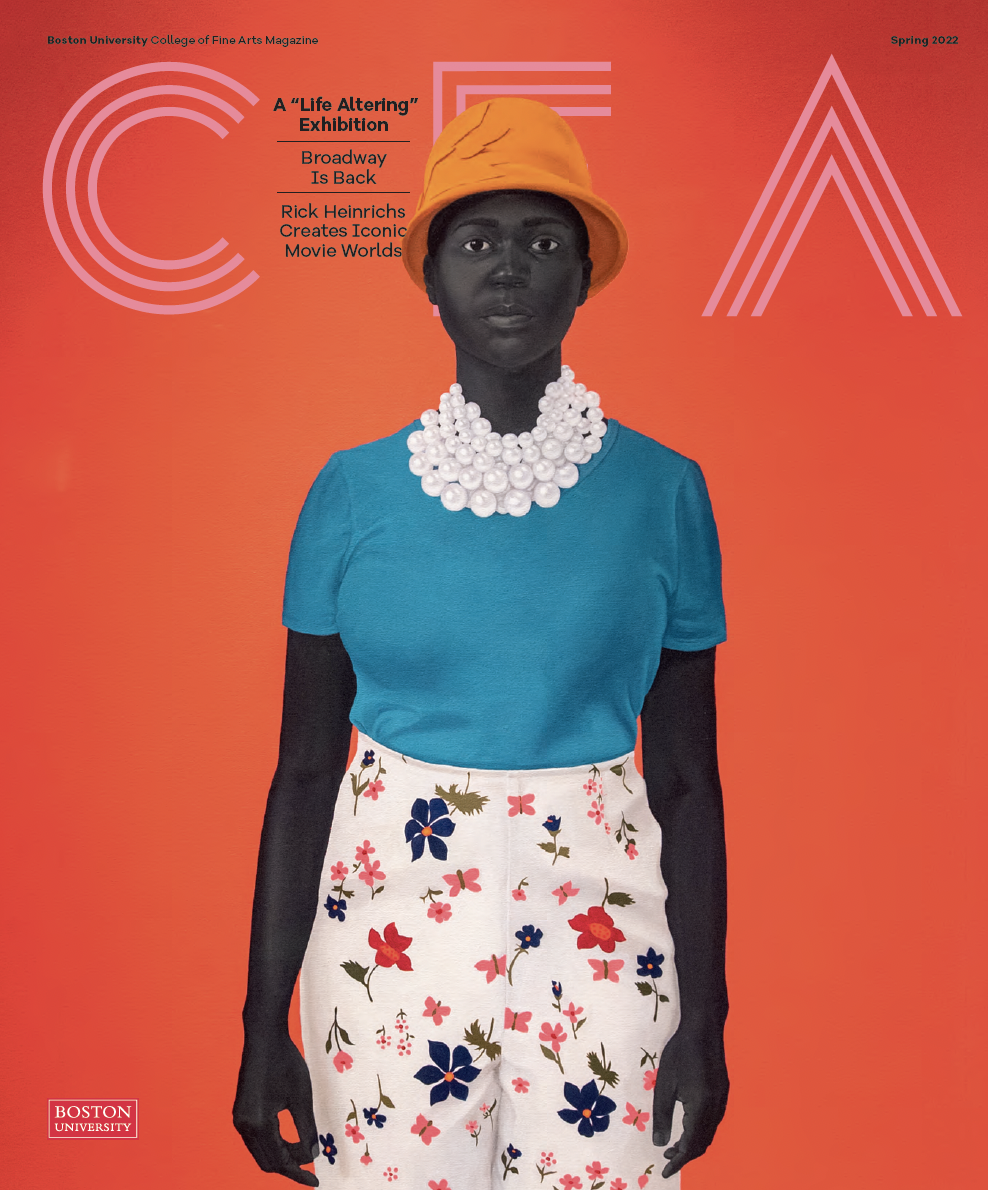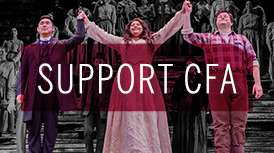Rick Heinrichs’ Magical Worlds
The production designer and CFA alum has overseen the creation of some of cinema’s most iconic places, from Gotham City to Halloween Town to a galaxy far, far away
By Marc Chalufour | Photo by Patrick Strattner

Heinrichs created this model of Jack Skellington, the protagonist of Tim Burton’s The Nightmare Before Christmas. © Disney
Tim Burton’s The Nightmare Before Christmas is a deeply macabre film. The star, a tuxedoed skeleton, has no eyes. His love interest tears her limbs off and sews them back on. A gang of trick-or-treaters kidnaps Santa Claus. A teddy bear gets dissected. Disney, concerned the creepiness wasn’t appropriate for its child-friendly brand, released the film under a different studio banner.
But the late film critic Roger Ebert saw magic. “The movies can create entirely new worlds for us, but that is one of their rarest gifts. More often, directors go for realism,” he wrote in 1993. “One of [Nightmare’s] many pleasures…is that there is not a single recognizable landscape within it. Everything looks strange and haunting.”
Though the film was created by Tim Burton and directed by Henry Selick, visual consultant Rick Heinrichs was critical to creating the immersive world of Nightmare’s Halloween Town. He translated Burton’s sketches into the first sculpture of the film’s protagonist, Jack Skellington, and was a visual consultant throughout production, helping to make Halloween Town a cohesive and believable setting for the stop-motion animated feature. The pair have partnered on 11 feature films—often with Burton directing and Heinrichs (’76) in charge of art direction or production design—including Edward Scissorhands (1990), Batman Returns (1992), and Sleepy Hollow (1999), for which Heinrichs won an Academy Award.
Over the past two years, he has helped filmmakers create J. R. R. Tolkien’s Middle-earth for The Lord of the Rings: The Rings of Power (Heinrichs helped launch the series, then departed) and transform a Grecian island into the set of a murder mystery for Knives Out 2—both scheduled for release this year. Heinrichs’ credits also include work on some of the most memorable worlds in film, including Star Wars (Star Wars: The Last Jedi) and Marvel (Captain America: The First Avenger).
“My fascination has always been the creation of an environment and trying to instill it with expressive quality and emotional content,” Heinrichs says. Few in Hollywood have been as successful. After working his way up through the art departments on both animated and live-action films, Heinrichs has become one of the most sought-after production designers in the business.

Heinrichs first collaborated with Tim Burton on the short film Vincent, about a young boy obsessed with horror actor Vincent Price. © 1982 Disney
HOLDING THE FABRIC TOGETHER
A production designer guides a project’s transformation, from an idea to a three-dimensional world filled with actors, sets, costumes, and lighting. Done well, the result can immerse audiences in a fantasy world. The job requires a photographer’s eye, a sculptor’s hands, and a painter’s sense of color. The more fantastical the world, the greater the challenge in making it believable. “The writers, directors, producers, and actors—it’s pretty easy to figure out who does what,” Heinrichs says. “The rest of a film’s credits are a little bit harder to understand. They’re not directly related to getting butts in the seats. Our contributions are more diffusely woven into the fabric of the film itself.” The production designer must make sure that fabric holds together.
“With Tim, and with all of the other filmmakers I’ve worked with, it’s always been about the director and their vision,” Heinrichs says. “It’s just so powerful, seeing something which coheres around a vision that’s propelled by the storytelling of the director.” And Heinrichs has worked with some of the best, such as Terry Gilliam, Ang Lee, and Joel and Ethan Coen.
ANIMATED DREAMS

An annotated sketch and sculpture Heinrichs created of Nightmare character Sally. © Disney
As a kid, Heinrichs loved films, especially Disney and Warner Bros. cartoons. Art became an escape from the rigid structure of school. “When I was, like, 10, I would draw these imaginary projects with situational themes—like a haunted house where every room had a horrible murder going on in it,” he says. “I think my parents were both amused and concerned.”
Heinrichs wanted to study animation in college, but there weren’t many programs available in the mid-1970s. He opted for a broad background in fine arts. “I spent my late teens and early 20s getting my hands dirty in drawing and painting and sculpture, graphic design, printmaking,” he says. He appreciates how that background continues to benefit his work. “You gain some mastery over depicting the human form in light—that’s a discipline you can apply to many other things.”
By the time Heinrichs graduated, animation programs were beginning to pop up—including one at the California Institute of the Arts (CalArts), where a number of Disney animators taught. “There was this whole group of like-minded individuals there,” he says. He met Brad Bird, John Lasseter, and John Musker (if you’ve watched a Disney or Pixar film in the past 35 years, you’re familiar with their work). He also met Tim Burton.
The two worked together on Disney’s 1981 film The Fox and the Hound, where they were responsible for drawing inbetweens—repetitive frames that create the illusion of motion following an animator’s key frame. “It was a bit depressing,” Heinrichs says. “You go to school and you’re told how amazingly inventive and creative you are—then you’re on an assembly line.”
While Disney didn’t wind up using Burton’s quirky, gothic sketches for their next project, The Black Cauldron, Heinrichs was inspired and began to sculpt the characters in three dimensions. “I thought they were very dimensional, but had that wonderful aspect of being very graphic and expressive at the same time,” he says. “In the work I’ve done with Tim, it’s turning graphic work into a kind of immersive world.” Their first film was the 1982 stop-motion animation short Vincent, based on a Burton poem.
The six-minute film tells the story of a young boy obsessed with horror actor Vincent Price. It’s dark and brooding and immediately identifiable as a Tim Burton work, with quirky characters and off-kilter structures.
A few years later, the two were sharing a studio in Pasadena when Burton began sketching scenes from a holiday poem he had written. “I saw this one drawing and almost immediately did a sculpture of Jack [Skellington],” Heinrichs says. He showed it to a stop-motion armature builder, who told him the legs were too thin. “So, I beefed everything up a little bit until he agreed he could make it. It was designed by everybody,” Heinrichs says. “As a result, you’ve got something never quite seen before, and that was a big part of the appeal. I want to work on a movie with other people. The fun is collaborating with them and coming up with something bigger than I could come up with on my own.”

Heinrichs won the Academy Award for Best Production Design for Sleepy Hollow. He created this sketch of the titular town (above). Courtesy of Rick Heinrichs (sketch); Entertainment Pictures/Alamy Stock Photo
EXPANDING THE GALAXY
While Burton’s films tend to occupy a world that is distinctively his, an increasing number of movies build upon existing fictional universes. Sequels, prequels, and reboots are big business, and Heinrichs has helped design some of the biggest—none more prominent than 2017’s Star Wars: The Last Jedi.
Heinrichs spent days in the Lucasfilm archives to prepare. He studied sketches and paintings done by the late Ralph McQuarrie, the conceptual artist who helped define the look of the original Star Wars trilogy in the 1970s and 1980s. “There’s a very identifiable look to the world he created. A simplicity of shape and color and lighting. It felt very modern and futuristic—but also weirdly retro at the same time,” Heinrichs says. His job was to carry that inspiration through a project that included 125 soundstage sets and locations in four countries. “That was the thing that was most exciting—coming up with elements that felt familiar and yet futuristic and cool.”
One of the film’s signature scenes unfolds on the planet Crait. It’s a classic Star Wars battle—good taking on evil against the backdrop of a unique landscape. Rickety Resistance ski speeders charge toward a menacing line of First Order AT-M6 Walkers. Laser blasts and shrapnel slice into the white mineral crust of Crait’s surface, sending red soil exploding into the air. The planet seems to bleed. The scene is reminiscent of the snowy battle on Hoth at the beginning of Star Wars: The Empire Strikes Back, but it also recalls a moment from another Heinrichs film: the blood-covered snow in Fargo’s infamous woodchipper scene.
Heinrichs values his CFA education and the way it helps him interpret a range of artistic influences. For Captain America: The First Avenger, he had decades of Marvel comics to draw on, as well as World War II photographs and propaganda. The challenge, he says, was “the idea of visually presenting this confrontation between fascism and democracy—what are the colors and the shapes that attend to those opposing forces?” For the 2019 live-action adaptation of Dumbo—another Burton collaboration—he cites the painter Edward Hopper as an inspiration. “Understanding how he paints and composes his designs—those things live in your head and they combine with other ideas, and they ultimately come out in a completely different form as design ideas for film.”

Heinrichs also worked with Burton on the 2019 live-action adaptation of Dumbo. © 2019 Disney
YOUNG AT HEART
As formative as BU, CalArts, and Disney were, it’s been his ability to hold on to his childhood passion for creating that continues to fuel Heinrichs. “Nothing compares to your first discoveries and explorations as a kid,” he says. “Tim [Burton] would say that everybody’s an artist when they’re six years old. There is a purity and naïveté and passion to the work you do then. And he would joke, ‘It just gets beaten out of you over time.’” For the partners, success is avoiding that fate.
Heinrichs served as a production designer on the upcoming Amazon Prime Video series The Lord of the Rings: The Rings of Power. Watch a teaser trailer here. Video courtesy of Prime Video
Heinrichs can’t say much about his latest projects, Knives Out 2 and The Lord of the Rings: The Rings of Power—both are in postproduction and scheduled for release later this year—but he continues to revel in world building. “It’s difficult to explain to other people how amazing it is to walk onto the sets and see what you’ve been imagining,” Heinrichs says. “It’s one of the reasons I love what I do.”
HEINRICHS’ HIGHLIGHTS
Rick Heinrichs got his start as an animation artist at Disney, but his big break came when he and Tim Burton produced a stop-motion animated short, Vincent, in 1982. The pair have since collaborated on 11 feature films. Heinrichs has worked his way up the creative ranks on both animated and live-action movies, and his design work and direction have enhanced some of the most memorable worlds in film. Here are some of the films that define Heinrichs’ career.
- Vincent (Short, 1982) • Producer, designer, sculptor
- Hansel and Gretel (TV movie, 1983) • Producer, model sculptor
- Pee-wee’s Big Adventure (1985) • Animator, animated effects supervisor
- Beetlejuice (1988) • Visual effects consultant
- Ghostbusters II (1989) • Set designer
- Edward Scissorhands (1990) • Set designer
- Batman Returns (1992) • Art director
- Tim Burton’s The Nightmare Before Christmas (1993) • Visual consultant
- Fargo (1996) • Production designer
- Sleepy Hollow (1999) • Production designer, Academy Award winner for production design
- A Series of Unfortunate Events (2004) • Production designer, Academy Award nominee for art direction
- Pirates of the Caribbean: Dead Man’s Chest (2006) • Production designer, Academy Award nominee for art direction
- Captain America: The First Avenger (2011) • Production designer
- Star Wars: The Last Jedi (2017) • Production designer
- Dumbo (2019) • Production designer
- The Lord of the Rings: The Rings of Power (TV series, 2022) • Production designer
- Knives Out 2 (2022) • Production designer










